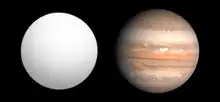WASP-7b
WASP-7b is an extrasolar planet discovered in 2008. This 5-day period planet is slightly smaller than Jupiter, roughly the same mass and more dense.[2]
 Size comparison of WASP-7b with Jupiter. | |
| Discovery | |
|---|---|
| Discovered by | Cameron et al. (SuperWASP) |
| Discovery site | SAAO |
| Discovery date | April 1, 2008 |
| Transit | |
| Orbital characteristics | |
| 0.0618+0.0014 −0.0033 AU | |
| Eccentricity | 0.0173+0.0009 −0.0011[1] |
| 4.954658+5.5e-5 −4.3e-5 d | |
| Inclination | 89.6+0.4 −0.9 |
| Star | WASP-7 |
| Physical characteristics | |
Mean radius | 0.915+0.046 −0.04 RJ |
| Mass | 0.96+0.12 −0.18 MJ |
Mean density | 1,660 kg/m3 (2,800 lb/cu yd) |
| 3.03 g | |
| Temperature | 1393+80 −82 K[1] |
A study in 2012, utilizing the Rossiter–McLaughlin effect, determined the planetary orbit is strongly misaligned with the equatorial plane of the star, with misalignment equal to 86±8°, making the planetary orbit nearly polar.[3] The orbit is also slightly eccentric, which is surprising given the tidal circularization timescale of below 650 million years.[1]
See also
References
- Trends in Spitzer Secondary Eclipses, 2021, arXiv:2103.15833
- Hellier; et al. (December 11, 2008). "WASP-7: The brightest transiting-exoplanet system in the Southern hemisphere". The Astrophysical Journal Letters. 690 (1): L89–L91. arXiv:0805.2600. Bibcode:2009ApJ...690L..89H. doi:10.1088/0004-637X/690/1/L89.
- Obliquities of Hot Jupiter host stars: Evidence for tidal interactions and primordial misalignments, 2012, arXiv:1206.6105
This article is issued from Wikipedia. The text is licensed under Creative Commons - Attribution - Sharealike. Additional terms may apply for the media files.